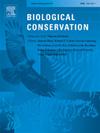Using GPS tracking data to validate the conservation value of bird migration counts
IF 4.9
1区 环境科学与生态学
Q1 BIODIVERSITY CONSERVATION
引用次数: 0
Abstract
Effective conservation of migratory birds requires gathering of information about their population trends, often acquired using migratory bird counts. These schemes ideally operate at migratory bottlenecks, through which a significant portion of the counted migratory populations is funneled. Yet it is rare to validate the conservation value of the data from these counts. Here we perform this validation using GPS tracking data collected from two migratory species during their movement over two count schemes: the globally endangered steppe eagle counted in Eilat, Israel, and the black kite, counted in Batumi, Georgia. We use tracking data to answer two questions: which populations are counted and what affects the probability that a given individual will be counted. Our results illustrate variability in the effectiveness of these two migratory bird counting schemes. Considering the goal of estimating population trends, we show that Eilat does not represent a good location for understanding population trends of steppe eagles, while Batumi appears to provide better information on demographic trends of black kites. We further present differences in annual and individual variability, evidence regarding the breeding area origins of the counted populations and effects of environmental factors on the raptors' routes and, consequently, on the probabilities of being counted. Beyond the direct implications of our results, this study provides an example of using telemetry data to parameterize inference from bird counts. Further coupling of migratory bird count data and GPS data can improve our understanding of migration ecology and the conservation of migratory species.
求助全文
约1分钟内获得全文
求助全文
来源期刊

Biological Conservation
环境科学-环境科学
CiteScore
10.20
自引率
3.40%
发文量
295
审稿时长
61 days
期刊介绍:
Biological Conservation is an international leading journal in the discipline of conservation biology. The journal publishes articles spanning a diverse range of fields that contribute to the biological, sociological, and economic dimensions of conservation and natural resource management. The primary aim of Biological Conservation is the publication of high-quality papers that advance the science and practice of conservation, or which demonstrate the application of conservation principles for natural resource management and policy. Therefore it will be of interest to a broad international readership.
 求助内容:
求助内容: 应助结果提醒方式:
应助结果提醒方式:


